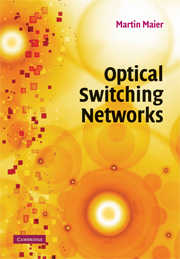Book contents
- Frontmatter
- Contents
- List of illustrations
- List of tables
- Preface
- Acknowledgments
- Part I Introduction
- Part II Optical wide area networks
- Part III Optical metropolitan area networks
- Part IV Optical access and local area networks
- Overview
- 14 EPON
- 15 WDM EPON
- 16 STARGATE
- 17 Gigabit Ethernet
- 18 Radio-over-fiber networks
- Part V Testbeds
- Bibliography
- Index
17 - Gigabit Ethernet
from Part IV - Optical access and local area networks
Published online by Cambridge University Press: 10 May 2010
- Frontmatter
- Contents
- List of illustrations
- List of tables
- Preface
- Acknowledgments
- Part I Introduction
- Part II Optical wide area networks
- Part III Optical metropolitan area networks
- Part IV Optical access and local area networks
- Overview
- 14 EPON
- 15 WDM EPON
- 16 STARGATE
- 17 Gigabit Ethernet
- 18 Radio-over-fiber networks
- Part V Testbeds
- Bibliography
- Index
Summary
Ethernet networks have come a long way and are widely deployed nowadays. In fact, 95% of today's local area networks (LANs) use Ethernet. Ethernet's transmission rate was originally set at 10 megabits per second (10 Mbps) in 1980 and evolved to higher speed versions ever since. A 100-Mbps version, also known as Fast Ethernet, was approved as IEEE standard 802.3u in 1995. In order to save time and standards development resources, physical signaling methods previously developed and standardized for Fiber Distributed Data Interface (FDDI) networks were reused in the IEEE standard 802.3u (Thompson, 1997). Fast Ethernet was immediately accepted by customers and its success prompted the development of an Ethernet standard for operation at 1000 Mbps (1 Gbps), leading to Gigabit Ethernet (GbE). The standard for Gigabit Ethernet, IEEE standard 802.3z, was formally approved in 1998. At present, 10-Gigabit Ethernet (10GbE) is the fastest of the Ethernet standards. The standardization of 10GbE began in March of 1999 and led to the 10GbE standard IEEE 802.3ae, which was formally approved in 2002.
In this chapter, we highlight the salient features of both 1 and 10 Gbps Ethernet. While 10GbE is the fastest existing Ethernet standard at the time of writing, it is worthwhile to mention that 10GbE does not represent the end of the development of ever-increasing higher-speed Ethernet networks. The standardization of 100-Gigabit Ethernet (100GbE) is currently under development by the IEEE 802.3 Higher Speed Study Group (HSSG). The HSSG was formed in 2006 and aims at providing a standard for 100GbE by the end of 2009.
- Type
- Chapter
- Information
- Optical Switching Networks , pp. 256 - 261Publisher: Cambridge University PressPrint publication year: 2008



